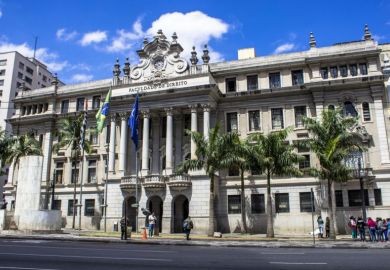Late last year, India’s president, Pranab Mukherjee, told a conference on industry-academic interaction that if India provides “enough funds to [the] top 10 to 15 institutions for the next four to five years, these institutions will certainly storm into the top 100 of global academic rankings within [the] next few years”. Unfortunately, his optimism is misplaced. That laudable goal will be difficult, if not impossible, to achieve in the short or medium term.
India’s higher education and research sectors have, for decades, been underfunded, especially in view of the tremendous growth in student numbers. Compared with the other BRIC countries, the proportion of Indian gross domestic product spent on education – 4.1 per cent – is second to Brazil. But India is bottom for research expenditure, committing just 0.8 per cent of its GDP, and it educates the lowest proportion of the relevant age group. So despite now having the largest higher education system in the world after China, the public and political clamour for more expansion is immense.
Indian higher education is also poorly organised to create world-class universities. No state government has a vision to do so, and none provides adequate funding to maintain high standards. The central universities are better funded and do not share with the state universities any of the immense, globally unique responsibility for supervising India’s 36,000 colleges. But they are still beset by a range of factors that make institutional change extraordinarily difficult. These include excessive bureaucracy, a promotion system that pays little attention to productivity and the occasional intrusion of local politics on to campus. This explains India’s tendency, when it wants to innovate in the sector, to create new institutions, such as the Indian Institutes of Technology, the Tata Institute of Fundamental Research or the Indian Institutes of Management. But doing this requires time and immense resources – and leaves the vast majority of the system wallowing in mediocrity.
Whatever the approach, creating world-class universities requires careful thought and planning, as well as considerable funding over the long run. India will need to consider whether it has the resources. If recognition in the global rankings is a goal, the challenges are even greater because the rankings are a moving target. There can be only 100 institutions in the top 100, and several other countries, such as Russia, Japan and China, are also spending big on their top universities. India is very much a latecomer to the world-class party.
Jamil Salmi and I analysed the experiences of 10 successful new universities in our 2011 book The Road to Academic Excellence: The Making of World-Class Research Universities. We found that while money is necessary, other elements are just as vital. One is a governance model that involves significant participation from – but not total control by – academics. Another is strong leadership: not only a visionary president but also competent administrative staff able to implement the university’s mission. A third element is enough autonomy to prevent the interference of governmental or private authorities, combined with reasonable accountability to external agencies. A fourth is top academic staff who are committed to the university’s mission (including teaching), paid adequately and provided with appropriate career ladders. Also important are academic freedom, highly qualified and motivated students, and a firm commitment to meritocracy at all levels.
Many efforts to develop world-class universities have focused solely on science and technology. These fields are certainly crucial, and they will bring dividends in the rankings because they produce many journal articles. Yet the social sciences and humanities are increasingly relevant to solving global problems and building critical and analytical skills in students. They are also becoming more recognised by the citation counters that matter for rankings.
India lacks a distinguished record of allowing universities significant autonomy in policy and the appointment of senior officials. Most observers have noted that many aspects of Indian higher education have been politicised. India’s “reservation system”, which earmarks close to half of student admissions and faculty appointments to particular disadvantaged groups, may work for some institutions and has increased social mobility for these students. But it will not permit the development of world-class research universities. Nor will siting new institutions in remote locations that need a development boost: top research universities are generally located near metropolitan centres.
India does have advantages. The use of English as the medium of much of its teaching and research puts it in the global linguistic mainstream. The country also has no shortage of well-trained and brilliant researchers, at home and abroad. A truly exciting and well-planned academic development could attract the Indian diaspora.
So while the road to world-class universities may be fraught, political support, thoughtful planning and much creative thinking could just be enough to complete the journey. One thing is clear: for India to take its legitimate place as a global intellectual power, world-class universities are a necessity.
Philip G. Altbach is research professor and founding director of the Center for International Higher Education at Boston College in the US.
Register to continue
Why register?
- Registration is free and only takes a moment
- Once registered, you can read 3 articles a month
- Sign up for our newsletter
Subscribe
Or subscribe for unlimited access to:
- Unlimited access to news, views, insights & reviews
- Digital editions
- Digital access to THE’s university and college rankings analysis
Already registered or a current subscriber?




